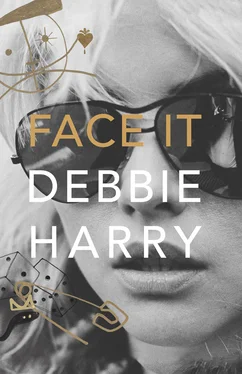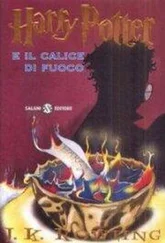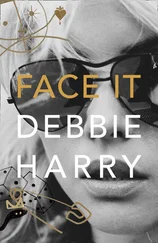1 ...6 7 8 10 11 12 ...15 Then I saw a blind ad in the New York Times looking for a secretary. It turned out to be for the British Broadcasting Corporation. This was my first link to what would become a long, lovely relationship with Great Britain. They gave me the job on the strength of the sensational letter that my uncle helped me write. Once they had me, they realized that I wasn’t very good at what I was supposed to do, but they kept me anyway and I grew into the job. I learned to operate a telex machine. I also met some interesting people—Alistair Cooke, Malcolm Muggeridge, Susannah York—who came into the office/studio for radio interviews.
Plus, I met Muhammad Ali. Well, not exactly met him. “Cassius Clay is coming in to do a TV interview,” they said, so I snuck around the corner and wow, I saw this big, beautiful man walk into the TV studio and close the door. It was a soundproofed room with a small window way up high, so I decided, being athletic, that I was going to grab the windowsill and pull myself up and watch the taping. But, as I pulled myself up, my feet kicked the wall with a thud. In a flash, Ali’s head whipped round and he stared right at me. He nailed me and I was transfixed. He’d responded with the animal instinct and lightning reflexes of the supreme champion he was . . . I quickly dropped down to the floor, shocked and excited by the primal exchange. I could have gotten into trouble, particularly if they had already started to record, but fortunately no one else in the room had even noticed.
The offices for the BBC New York were in the International Building at Rockefeller Center, directly across from the monumental St. Patrick’s Cathedral. When I was working at the BBC, I believe Fifth Avenue was a two-way street, and the traffic was immense. A block south of the cathedral was Saks Fifth Avenue. In front of the International Building was and still is the enormous bronze statue of Atlas holding up the world. Behind it is Rockefeller Plaza, where the skating rink and the big Christmas tree are located during the holidays. During the summer the rink becomes an outdoor café. Directly behind the rink is the NBC building, with the Warner Bros. offices nearby too.
Strolling past the store windows and through the canyons of buildings was always interesting, and I made it a point to go over to visit one of my favorite characters, “Moondog.” This tall, bearded old man with his horned Viking helmet was a vision. He stood on the corner of Sixth Avenue and Fifty-Third in his long reddish cape holding his spearlike pole, selling booklets of his poetry. Moondog now has his own Wikipedia page, but back then few people who walked past him knew who the fuck he was. Most people steered clear of or didn’t even notice him—just another crazy “weirdo” to avoid or blank out.
Some thought he was an eccentric, blind, homeless man, but he was much more. Moondog was also a musician. He had an apartment uptown but kept his image and his privacy closely guarded. He designed instruments and also recorded, and he became adored by most New Yorkers. A beloved fixture, a true New York character who sometimes recited his poems to the businessmen and tourists hurrying past him. He was freaky but he was fondly called the Viking guy—even if no one knew about all his artistic achievements.
And then there were the more sinister types: the silent men in black selling small newspapers or booklets. They were serious, intense, kind of scary, which made them all the more intriguing, of course. They called themselves “the Process”—short for the Process Church of the Final Judgment—and were scary but compelling in their intensity. Never alone, they stood in groups on the midtown corners in their quasimilitary black uniforms.
Scientology wasn’t so well-known at the time, but cults, communes, and radical religious movements would come and go all the time. I wasn’t aware completely of Scientology or the Process Church, but I respected the commitment it took for these guys to stand and deliver in midtown to a straight bunch of bros. They roamed around downtown as well, among much more sympathetic audiences in the West and East Village.
It was a business, it was a religion, it was a cult; maybe it still is but I don’t think they call it the Process anymore.
I had come to the city to be an artist, but I wasn’t painting much, if at all. In many ways I was really still a tourist, just experiencing the place, having adventures, and meeting people. I experimented with everything imaginable, attempting to figure out who I was as an artist—or if I even was one. I sought out everything New York had to offer, everything underground and forbidden and everything aboveground, and threw myself into it. I wasn’t always smart about it, admittedly, but I learned a lot and came out the other side and kept on trying.
Drawn to music more and more, I didn’t have to go far to hear it. The Balloon Farm, later called the Electric Circus, was on my street, St. Mark’s Place, between Second and Third. The old building the shows were held in had some serious history: from mob hangout, to Ukrainian nursing home, to Polish community hall, to the Dom restaurant. The whole neighborhood was Italian, Polish, and Ukrainian. Every morning, on my way to work, I would see the women in babushkas with their buckets of water and brooms, washing the sidewalks clean of whatever went on the night before. A ritual carryover from the old country.
Trying to keep time at the Mudd Club.
Allan Tannenbaum
One evening, as I walked past the Balloon Farm, the Velvet Underground was playing, so I went inside and into this brilliant explosion of color and light. It was so wild and beautiful, with a set designed by Andy Warhol, who was also doing the lights. The Velvets were fantastic. John Cale brilliant, with his droning, screeching electric viola; proto-punk Lou Reed with his hypercool, drawling delivery and sneering sexuality; Gerard Malanga, gyrating around with his whip and leathers; and the deep-voiced Nico, this haunting, mysterious Nordic goddess . . .
Another time, I saw Janis Joplin play at the Anderson Theater. I loved the physicality and the sensuality of her performance—how her whole body was in the song, how she would grab the bottle of Southern Comfort on the piano and take a huge slug and belt out her lines with crazed Texan soul. I’d never seen anything like her onstage. Nico had a very different approach to performing; she just stood there, still as a statue, as she sang her somber songs—much like the famed jazz singer Keely Smith, with the same stillness but a different kind of music.
I would go see musicals and underground theater. I bought Backstage magazine and I’d take notes on all the auditions and then join the endless lines of hopefuls who, along with me, never got past first base. There was also a strong jazz scene on the Lower East Side with haunts like the Dom, the renowned Five Spot Cafe, and Slugs’. At Slugs’, in particular, you’d get to hear luminaries like Sun Ra, Sonny Rollins, Albert Ayler, and Ornette Coleman—and find yourself at a table next to Salvador Dalí. I met a few of the musicians. I remember showing up and sitting in on a couple of loose, “happening”-like gatherings, the Uni Trio and the Tri-Angels—free, abstract music where I sang a bit or chanted and banged some percussion instrument or other. That was the same thing we did in the First National Uniphrenic Church and Bank. The leader was a guy from New Jersey named Charlie Simon who later christened himself Charlie Nothing. He made sculptures out of cars that he called “dingulators” that you could play like guitars. He also wrote a book called The Adventures of Dickless Traci, a detective novel with a weird sense of humor, but that was later. He was multidimensional in music, art, and literature—a free spirit who was more beat than hippie. And he made me curious. I liked the curiosity because I was curious myself. If any other guy had come along and played me a track from a Tibetan temple with men giggling and growling in the background, I would have liked him too.
Читать дальше












